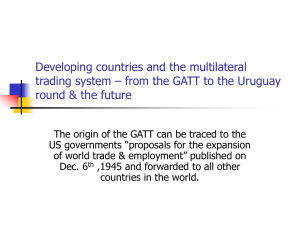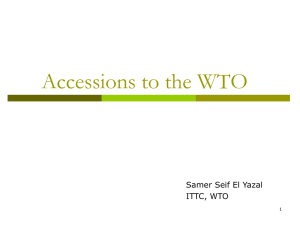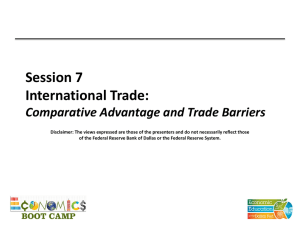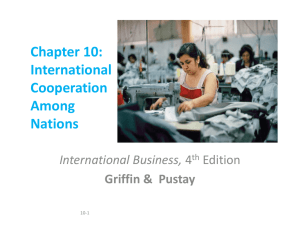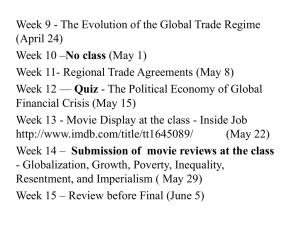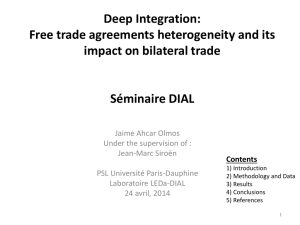World Trade Regimes
advertisement
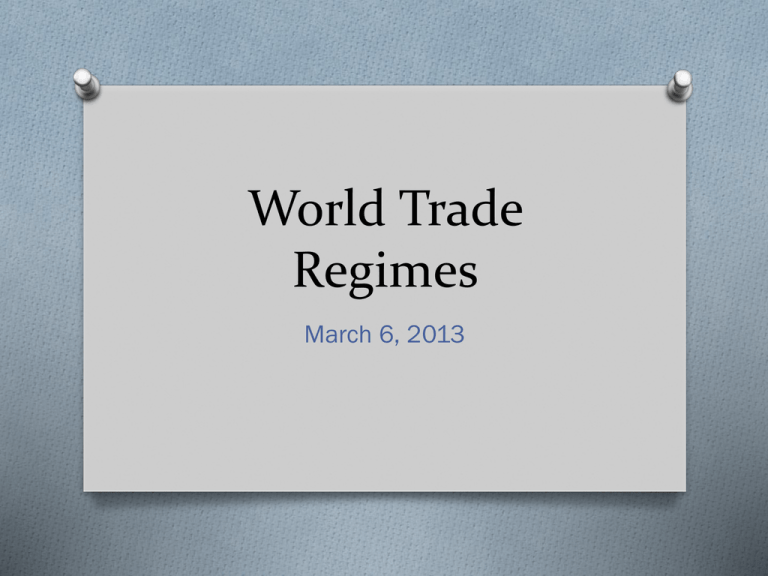
World Trade Regimes March 6, 2013 Trade Regimes Before 1947, there was little in the way of a framework for organizing trade. Any agreements on trade were generally bilateral (between two countries). Sometimes wars were fought over trade and related issues (the 1812 war between the US and Great Britain being one), as were the “Opium Wars” between Great Britain and China in the mid 19th Century. But aside from treaties and war, states themselves most often regulated the flow of trade over their borders insofar as such activities could be controlled. Response to Great Depression Discussions among the Allies during WWII and conferences after the war led to a set of conclusions: 1. That individual national responses to the problems created by the Great Depression served to make the depression worse for most countries and made it last longer. These responses generally came in the form of the unilateral imposition of protectionist measures meant to shield domestic industries from foreign competition. As a result, trade volume dropped dramatically and most countries lost ground economically. Great Depression Conclusions: 2. Thus, the attempts by individual countries to help themselves ended up hurting all countries, including those that set up barriers. This was a type of reverse invisible hand– selfinterested moves by individual governments ended up reducing the utility of everyone rather than increasing it. Great Depression Conclusions: 3. The deepening and lengthening of the Depression was a direct cause of WWII, in part because it helped bring the Nazis to power in Germany. 4. Thus to avoid another world war, international agreements should be in place to help prevent this chain of events from happening again. 5. These agreements should be facilitated by an international organization, in the same way that the resolution of political problems was to be facilitated by a similar type of institution. GATT The result was GATT: the General Agreement on Tariffs and Trade, an international organization set up in 1947 to facilitate freer trade on a multilateral basis. Foundation assumptions of GATT: O Free trade better than regulated trade O Free trade is best guaranteed through multilateral agreements O Multilateral agreements facilitated by the presence of an international organization. All of these mark GATT as part of a liberal internationalist approach to international relations. GATT GATT lasted until 1995: O Headquarters in Geneva O Small staff O Functioned as facilitator and judicial body rather than an enforcement body: O Negotiating forum O Arbitrate trade dispute O Clarify rules O Assist states to observe rules WTO World Trade Organization, created in 1995 as the successor to GATT. Similar in: O Embodying belief that multilateral agreement to freer trade is good O Serves as multilateral negotiating platform O Performs judicial functions O International institution O Incorporates GATT agreements unless later superseded by new agreements. WTO Differences from GATT: O Larger staff O Enforcement powers O Enlarged free trade agenda to include services and intellectual property O Larger membership, now including newly industrialized countries and countries that had not been very active participants in capitalist world trade patterns (Vietnam, PRC, Russia, countries in Eastern Europe) WTO Free trade generally means the lowering or elimination of trade barriers that act as protectionist measures. While the WTO works to promote free trade, it’s immediate goal is not to push for the elimination of all trade barriers. Instead, it’s foundational principles are reciprocity and nondiscrimination– creating a framework in which it attempts to equalize trade barriers among countries in a global framework. WTO O These are achieved by institutionalizing the principle that Most-Favored Nation Status is extended to all member states of the WTO. O MFN status: State A receives the same trading benefits from State B that State B extends to its most preferred trading partner. Trade Negotiations Besides using MFN status as a tool for equalizing trade barriers, both the GATT and WTO have attempt to change the type of trade barriers nations use by encouraging them to convert from non-tariff barriers to tariffs, then to lower tariffs over time. Reasons? Negotiations Trade negotiations under both GATT and WTO generally occur by means of multi-year rounds of negotiations that concentrate on particular issues and economic sectors. Kennedy Round: problems of European integration Tokyo Round: global interdependence Uruguay Round: agriculture WTO One difficulty in successfully concluding a round of negotiations is the requirement of consensus: all countries must agree, which means one country can veto an agreement The larger the group, the more difficult it is to find consensus. Thus it is to be expected that rounds conducted under the WTO will be more difficult to conclude successfully than those conducted under GATT Specific Difficulties Why can’t countries just agree to lower or eliminate all trade barriers: O Different situations of different countries, including poor and newly industrializing countries, which may require more protection O Existing agreements among countries O Need for countries to negotiate with domestic constituencies that would bear the immediate burden of lowered barriers. O States in general benefit unevenly even if lowering of barriers benefits the world economy as a whole Current Problematic Areas O Resistance of newly industrializing countries to the imposition on them of quality, environmental and working condition standards by established industrialized countries. O Resistance of industrialized countries to ending agricultural subsidies O Financial services regulations O Protection of intellectual property (copyrights, patents). Other Free Trade Operations Bilateral Agreements: Agreements between two countries that contain reciprocal arrangements to lower trade barriers on all or selected trade items. These types of agreements (along with free trade areas) are contrary to the spirit and purpose of the WTO, which is dedicated to created a uniform and universal trade environment through multilateral agreements. Reasons Why bilateral agreements given the existence of GATT/WTO? O Difficulties of concluding WTO rounds O Address specific trade topics not included in WTO negotiations O Need for, or ease of, agreement with a few partners with which a country does a large volume of trade. Multilateral NonWTO agreements Not all multilateral trade agreements that create reciprocal trade arrangement are under the control of the WTO. Regional groupings of states may create such agreements. Again these are contrary to the WTO goals of uniformity and universalism. Indeed, such arrangements are competitive with and sometimes a substitute for WTO agreements, and insofar as they proliferate and serve the needs of countries, they could displace WTO agreements and perhaps the entire WTO framework. The fear, however, is that without a strong WTO framework: O World trade will not increase as much as is possible O The world will be divided among three or four zones, in which trade is free within each zone, but remains substantially burdened between zones FTAs Free Trade Areas are regional areas of free trade that result when a specified group of countries successfully conclude a multilateral set of negotiations that remove most or all trade barriers. Examples: North American Free Trade Area, ASEAN-China, EU Customs Unions Customs Unions are the result of negotiations that not only create a free trade area, but also result in agreement on a common tariff towards states that are not part of the agreement. Example: Customs Union of Kazakhstan, Belarus and Russia, Arab Customs Union Common Markets Common Market: FTA plus customs union plus coordination of other economic policies, such as monetary exchange. Examples: EU euro zone, Southern Zone Common Market (Mercosur) Other factors in the growth and facilitation of world trade Cartel: an association of producers or consumers of a product that is formed to manipulate the price of the product on the world market. Producers: control the supply of a product on the world market Consumers: collaborate to limit or otherwise coordinate demand for a product on the world market (or try to affect supply by creating reserves) OPEC Perhaps the most famous cartel is the Organization of Petroleum Exporting Countries: O Control about 40% of the world’s oil production O Well organized with an formal institution complete with headquarters in Vienna O Uses its position not only to manipulate price to enrich members, but also to: O Influence political behaviors and events, reward friends and punish opponents (oil boycott of the 1970s in aftermath of Arab-Israeli war) O Influence the world economy OPEC While it is well organized and has institutions in place that allow all members to participate in decisionmaking, it is dominated by Saudi Arabia due to the latter’s large contribution to the world’s oil supply: O Heavily influence decisions in OPEC O Can move independently of OPEC because it can influence world prices by itself O Conservative and since the late 1970s has generally been more rather than less cooperative with the West in terms of political goals and willingness to adjust supplies to ease global or Western economic difficulties. O Tends to think in the long rather than short term Other cartels O International Energy Agency: cartel of energy consumers that attempts to keep world energy prices low and stable by coordinating energy policies among nations and maintaining a reserve supply of oil. Not very successful O Fair Trade organizations, which are cartels of suppliers and consumers of such items as coffee, chocolate. Stabilize prices, provide fair and guaranteed incomes to farmers, liberate farmers from control of multi-national corporations. Other Non-State Actors Not all the important actors in negotiations over free trade are states or organizations of states. Private organizations also play a role: Industry groups: lobby to gain concessions or to protect existing concessions. These are particularly important in the areas of agriculture and intellectual property rights Non-State Actors O Labor Unions and Organizations: also attempt to create or protect concessions O Advocacy Groups and Non-Governmental Organizations (NGOs): attempt to influence negotiations to include protections for the environment, children, women, workers in general across national boundaries Enforcement of Trade Rules O Bilateral agreements may have their own special forums or have stipulations that accusations of violations or other disputes be heard by a third party arbitrator. O Customs Unions, FTAs and Common Markets will have internal organizations that are tasked with dealing with violations of bilateral rules. O National: States themselves can have agencies and legislation that can levy retaliatory tariffs and other measures when countries violate either bilateral, multilateral or WTO agreements. WTO Enforcement O If the trade in question is within the framework of the WTO, then the country that is the subject of another country’s retaliatory measures can appeal to a “WTO hearing” to argue that the measures are wrong or disproportionate. O If such a hearing finds that the measures are disproportionate, the WTO can allow the aggrieved nation to respond in kind Backlash Against WTO Enforcement O Perception that the WTO is the tool of O Industrialized countries O Global corporations O Secret, unaccountable, undemocratic bureaucracies O Resistance to free trade in general: O High wage workers in industrialized countries O Environmental organizations– leads to environmental damage O Advocacy groups: leads to exploitation of workers, particularly children
